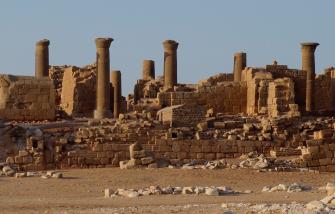Amara West is a town site about 100 kilometres south of the Second Cataract. It was founded under Pharaoh Seti I and served as the administrative centre of the southern part of the Nubian province in the later New Kingdom. Read more ...

900 to 300 BC
Napatan period
After 900 BC, a new indigenous power developed in the area of Jebel Barkal. Its rulers oriented themselves towards Egypt for their regal display. They adopted Egyptian gods, primarily the state god Amun, whose temples at Jebel Barkal and Kerma they revived or continued to operate. They employed Hieroglyphic Egyptian for their inscriptions and called themselves Kushites, adopting the term which the Egyptians had used for the Kerma people. The political entity which they founded, the so-called Kingdom of Kush, controlled the fate of the Middle Nile valley for more than one millennium. The first half of this period is called the Napatan, as the main settlement of the ruling elite was at Napata, a town at the foot of Jebel Barkal, near present-day Karima.
The oldest testimony of the Napatan kings is the royal cemetery at Kurru with a series of elite tombs, representing a sequence of successive rulers and their consorts. While the superstructures of the earliest tombs were tumuli i.e. earth mounds, the later burials were covered by pyramids.
By 750 BC, the expansionist Kushite rulers had extended their influence towards the north and set out to conquer Egypt, where they ruled as the 25th dynasty. Interestingly, they portayed themselves as the true keepers of Egyptian culture and tradition in their official propaganda. In 664 BC, they were expelled from Egypt by the Assyrians and contended themselves with conquering new dominions to the south and east after that.
Taharqo, the most important king of the 25th dynasty, left the cemetery at Kurru, opening a new burial ground at Nuri, upstream of Jebel Barkal. Nuri became the necropolis of the Napatan rulers and their family for the following centuries, up to the movement of the royal cemetery to Meroe.









